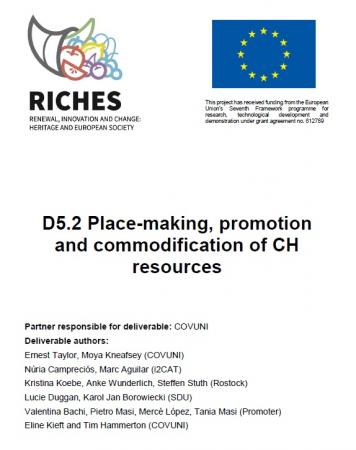Place-making, promotion and commodification of CH resources (RICHES project)

“This study explores the role of place making and promotion in the commodification of cultural heritage resources and how digital technologies intertwine with these processes. This research examines whether locations have coherent strategies to appeal to consumers using cultural resources and attributes such as place
promotion, product and quality. Analysis will centre on the contemporary influences and contribution of digital technologies in the exploitation of cultural heritage. The study adopts a culture economy approach, which is concerned with the exploitation of cultural products for achieving territorial development goals. These products comprise historical and pre-historical sites, landscapes, artisanship, languages, dialects, folklore, drama, literary references and visual arts. A further dimension under consideration is the watering down or ‘Disneyfication’ effect of commodification on place image and identity. This relates to practice or situations where cultural items, interpretations and rituals are homogenised or diluted to the extent that they are no longer meaningful or representative of local people...
While digital technologies can provide exciting windows and access routes into cultural heritage, there are also challenges around how to promote a deeper and more lasting engagement with cultural heritage. In this context, the practice of commodification appears to present a paradox to heritage promoters. The dilemma is how to attract visitors, preserve cultural heritage assets and maintain the cultural meaning(s) for local people, simultaneously. Part of the solution is increased diversification – both in terms of audience and employing a range of activities to avoid pressure solely on one attraction. Striving for equilibrium in the exploitation of cultural heritage promotes an increase in the diversity of activities, usage and education content, which helps to augment a more robust refashioning of cultural heritage sites as spaces of consumption…” (p.6-7)
